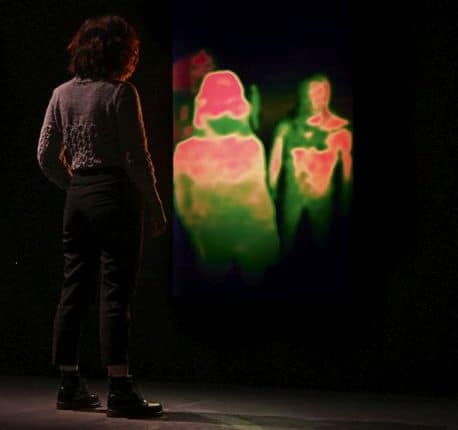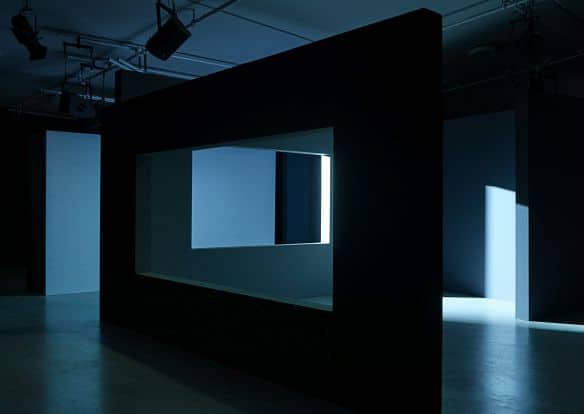Het kan weer. De eerste drempel waar ik na lange tijd van online-cultuur weer over stap is die van Eye Filmmuseum. Er eindelijk weer echt zijn, midden tussen de installaties van Vive le Cinéma. Speciaal gecreëerd voor Eye en International Film Festival Rotterdam, stonden ze hier in de expositieruimte al vier maanden stilletjes op publiek te wachten. Deze tentoonstelling van Eye en IFFR is een de activiteiten waarmee zij dit jaar hun respectievelijk 75- en 50-jarig bestaan vieren.
De titel is uitdagender dan op het eerste gezicht lijkt. Vive le Cinéma! Niets lijkt immers een vanzelfsprekender uitroep voor deze twee aan film verslingerde organisaties. Maar wat ik hier in Eye zie is niet allemaal even vanzelfsprekend. Is het nog cinema als ik voor een wonderlijk scherm sta waarin ik mezelf als een soort veelkleurig silhouet terugzie?
Geesten

De Argentijnse filmmaker Lucrecia Martel (Zama) gebruikte voor deze digitale spiegels infraroodcamera’s die op de bezoeker zijn gericht. Menselijke gedaanten veranderen daardoor in een soort spookachtige verschijningen. Op het scherm zie ik dat andere gestalten zich bij me voegen, maar als ik omkijk zie ik niets. Zijn het geesten?
Wie later (of vooraf) op de website de informatie leest en het aan Martel gewijde video-essay bekijkt zal ontdekken dat die geestenassociatie zo gek niet is. Het thema van verdwenen volkeren duikt ook in haar films op. Zo ben ik in deze fysieke expositieruimte toch ongemerkt in de virtuele verbeeldingsruimte van de maker terechtgekomen. Zou je kunnen zeggen. Want zulke ongewone installaties kunnen natuurlijk heel verschillende associaties oproepen.
Zo doet de Eye Machine van Carlos Reygadas iets heel anders. Het is geïnspireerd door het feit dat we blikken van vreemden doorgaans vermijden. Tevens een soort omkering van het kijken naar film. Nu wordt ik zelf bekeken. Reygadas construeerde een kermisachtige attractie. Een soort blind date-carrousel waarin je uitgenodigd wordt met willekeurige anderen een kort gesprekje te voeren. Heel vermakelijk, hoewel misschien iets te hoog gegrepen. Allerlei regels, camera’s en overbodige beeldschermen lijken me wat veel van het goede. Maar toch, doen!
Wild plan
Eye-directeur Sandra den Hamer herinnert zich dat het project ontstond als een wild plan. Drie jaar geleden uitgedacht tijdens een lunch met IFFR-collega’s. Namelijk om vijf eigenzinnige filmmakers nu eens te vragen het tweedimensionale doek te verlaten. Ze kregen de opdracht werk te maken dat de mogelijkheden van de driedimensionale ruimte gebruikt.
Jia Zhang-ke (China), Leopold Emmen (gezamenlijk pseudoniem van het Nederlandse duo Nanouk Leopold en Daan Emmen), Lucretia Martel (Argentinië), Lemohang Jeremiah Mosese (Lesotho) en Carlos Reygadas (Mexico) namen de uitdaging aan. Voor enkelen van hen was het zelfs de eerste keer dat ze zoiets deden.
De volledige titel van het evenement is overigens Vive le Cinéma! Art & Film. Dat maakt al iets duidelijker dat het niet om traditionele cinema gaat. Het draait hier juist on de overschrijding van gebruikelijke grenzen tussen kunstvormen. Met een duidelijke hint naar de gevleugelde woorden van Hubert Bals, de eerste directeur van IFFR: ‘Film is filmkunst is kunst’.
Dat beeldend kunstenaars soms de overstap naar film maken is niet ongewoon. Het omgekeerde, zoals hier, gebeurt minder vaak. Dat maakt ook dat het minder vanzelfsprekend is wat dit zou kunnen betekenen en hoe je het kan interpreteren. Wijst het terug naar de beginjaren van de cinema, toen er ook met allerlei curieuze curieuze machines werd geëxperimenteerd? Probeert het de relatie tussen kijker en beeld te onderzoeken?
Experiment
Wie zin heeft kan er allerlei filosofieën aan vast knopen. Maar je kan het project wat mij betreft ook gewoon zien als een intrigerend experiment met heel verschillende uitkomsten. Kunstwerken rond een spel met blik en camera, beeld en fysieke aanwezigheid. Wel zijn het allemaal experimenten die afstand nemen van de traditionele verhaalvorm.
Twee van de deelnemers maakten met betrekkelijk vertrouwd beeldmateriaal een omgeving die vooral uitnodigt tot goed kijken. Anderen gingen een stapje verder. Intrigerende installaties waar je het best met open houding en de nodige nieuwsgierigheid in kan rondwandelen.

Letterlijk zelfs, zoals in de installatie 5 Scenes at a Walking Pace van Leopold Emmen. Dat het niet de eerste keer is dat dit duo zich met installatiekunst bezighoudt zie je af aan de uitvoering. Het verwijst naar de manier waarop Leopold zich bij het maken van haar films door locaties en ruimtes laat inspireren. Zie hiervoor het fraaie video-essay dat Jan Pieter Ekker en Dana Linssen hierover maakten, een heel mooie toevoeging.
Kleur en licht
De installatie van Leopold en Emmen kan je zien als een locatie voor een ultra-minimalistische film. Bijna alles wat we normaal met film associëren is weggestript. Geen acteurs, geen herkenbare objecten, geen verhaal. Wel ruimtelijke contouren, wanden, doorkijkjes.
Een compositie van strakke vormen, licht en geluid. In het donker gloeien steeds veranderende kleuren op. Plots dwaalt een helderwit geprojecteerd vierkant rond. Ik zie schaduwen van mezelf en andere bezoekers. En er is muziek. Dat laatste komt me voor als een kleine knieval. Want roept deze omgeving zelf nu gevoelens op door kleur en licht? Of is het toch, zoals vaak in films, de soundtrack? Bij mij doet de muziek in ieder geval het meeste werk. Maar ik hoor dat iemand anders zich helemaal in het kalme kleurenspel verloor. De website waagt zich zelfs aan de beeldspraak dat je hier al wandelend een personage in je eigen film wordt. Wie weet.
Neem er in ieder geval de tijd voor. Misschien was ik er zelf te kort om te ontdekken dat er toch vijf ‘scènes’ ontstaan. Ook de andere installaties moet je niet te snel willen doen. Het conceptuele gehalte is redelijk hoog. Het kan goed zijn om via de teksten op de website of het bekijken van de aan dit project gekoppelde video-essays (online te zien) wat voorwerk te doen. Of juist beter achteraf? Waarschuwing: wie er het liefst blanco instapt kan nu doorscrollen naar het kopje ‘Films en video-essays’.
Het lichaam als landschap

Mosese, een van de meest belangwekkende nieuwe Afrikaanse filmmakers, koos voor een sobere aanpak. In de ruimte die hij heeft ingericht sta je tussen zes schermen. Beelden van rituele wassingen, close-ups van handen of gezichten en meer van dergelijke intieme, lichamelijke momenten. Het roept een bijzondere sfeer op. De website spreekt zelfs van een ‘overweldigende installatie waarin de representatie van zwarte vrouwenlichamen centraal staat’. Maar ik zie ook paarden en een dansende man in een extatische trance. Een rijk, menselijk panorama, al is ‘overweldigend’ wat mij betreft dan weer een te zwaar woord.
Wat me meer aansprak was de toelichting die Mosese vooraf via zoom aan de verzamelde journalisten gaf. Namelijk dat hij zich had laten inspireren door het landschap van het menselijk lichaam. Sprekende beelden die het verlangen naar zijn films alleen maar groter maken. Films die deze zomer inderdaad ook in Eye te zien zijn. Het video-essay over Mosese is een mooie inleiding.
Surveillance-camera’s
Dat een betrekkelijk ongecompliceerde aanpak juist heel goed kan werken blijkt vooral uit de installatie Close-Up van de Chinese filmmaker Jia Zhang-ke (Ash is Purest White). Hij verwijst hiermee naar de alomtegenwoordigheid van surveillance-camera’s. Als ik in de installatie om me heen kijk zie ik op vijf schermen beelden van een druk kruispunt in een Chinese stad. Pure registratie door bewakingscamera’s, lijkt het. Tot een van de beelden langzaam inzoomt op iemand die onzeker om zich heen kijkt en peutert aan een verband om zijn duim. Is dit ook gevangen door een van de camera’s rond het kruispunt, of zien we hier de hand van de filmmaker? En valt er dan nog meer te ontdekken wat me aanvankelijk ontging?
Eerlijk gezegd had ook Jia via zoom al een tipje van de sluier opgelicht. Juist door die huidige overvloed aan camerabeelden – zeker in China – was hij zich gaan realiseren dat cinema alleen maar belangrijker wordt. Alleen daarmee kan je een individu uit de anonimiteit lichten. Menselijke details laten zien, een verhaal vertellen. De bewakingscamera’s laten alles zien maar zeggen niets. Alleen in handen van de filmmaker kan de camera iets vertellen over het leven.
Films en video-essays
Deze vijf installaties vormen het hart van een uitgebreid programma. Er is een online-platform met veel informatie, artikelen en korte films. Daar vinden we ook de video-essays die onder meer ingaan op thema’s en motieven in de films van de regisseurs.
Een aantal van die films zul in de loop van de komende maanden ook ook in Eye te zien zijn, met inleidingen. De aftrap is op 16 juni met This is Not a Burial, It’s Resurrection van Mosese, voorafgegaan door een gesprek met de maker.
Bij de tentoonstelling is ook een lespakket gemaakt voor het voortgezet onderwijs, naar aanleiding van het werk van Nanouk Leopold en Daan Emmen.
Goed om te weten:
Vive le Cinéma! Art & Film is tot 5 september in Eye te bezichtigen. Meer informatie plus video-essays zijn te vinden op het speciale online-platform. Het lespakket is te gratis te downloaden bij LessonUp.
